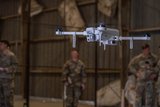What could the realignment of China, Russia, India and Pakistan mean for defence aerospace markets?
Pakistan is linked to China as its main supplier of combat aircraft. (Photo: Pakistan Air Force)
Most political alliances exist with a degree of tension. Even those forged in the white heat of existential threat tend to fray once life returns to the status quo ante. This is currently evident in Donald Trump’s policy of dismantling 80 years of general cooperation across NATO and its wider allies.
While much debate in the West has focused on the Atlantic issue and its knock-on effect for Australia, Japan or South Korea, other powerful forces are at work. It has long been anticipated that the populous nations to the south and east of the core G7 would become
Already have an account? Log in
Want to keep reading this article?
More from Air Warfare
-
![Dubai Airshow 2025: Anduril and Edge joint venture unveils Omen tailsitter UAV]()
Dubai Airshow 2025: Anduril and Edge joint venture unveils Omen tailsitter UAV
The Group 3 UAV has also netted its first order from the UAE for 50 platforms, with full-scale production scheduled for 2028.
-
![Russian fighter jet exportability threatened by sanctions, says think tank]()
Russian fighter jet exportability threatened by sanctions, says think tank
The think tank realised its report just days before the Dubai Airshow, where the Su-57E Russian fighter jet and Yak-130M trainer and light attack aircraft will make their Middle Eastern debuts.
-
![Analysis: South American domestic drone programmes fly high]()
Analysis: South American domestic drone programmes fly high
While South American militaries will continue to import drone technology from extra-regional suppliers, the successful test of a locally manufactured kamikaze drone by the Brazilian Navy demonstrates the rising role of “made in South America” systems.
-
![UAE: Domestic industries set to dominate the country’s $5.24 billion UAV market]()
UAE: Domestic industries set to dominate the country’s $5.24 billion UAV market
The UAE is the second-highest spender on uncrewed aerial vehicles in the Middle East and the 15th-highest spender on the capability globally.























